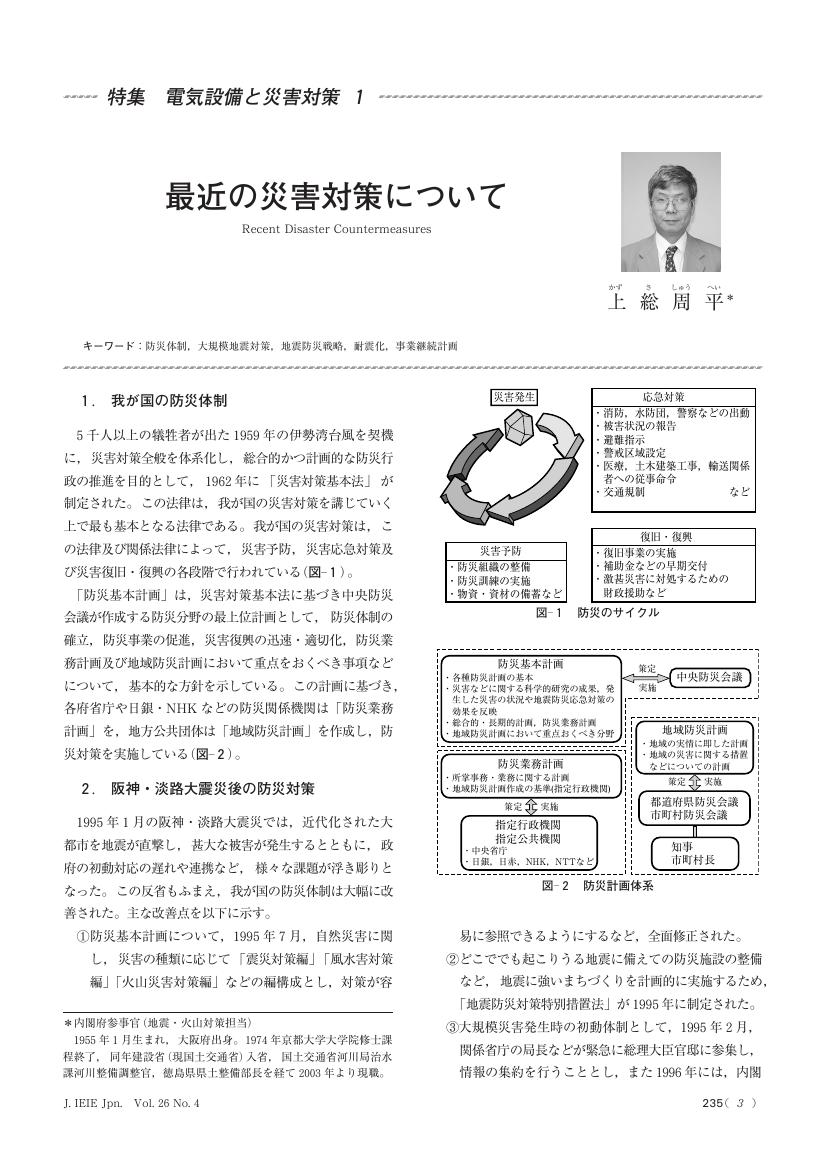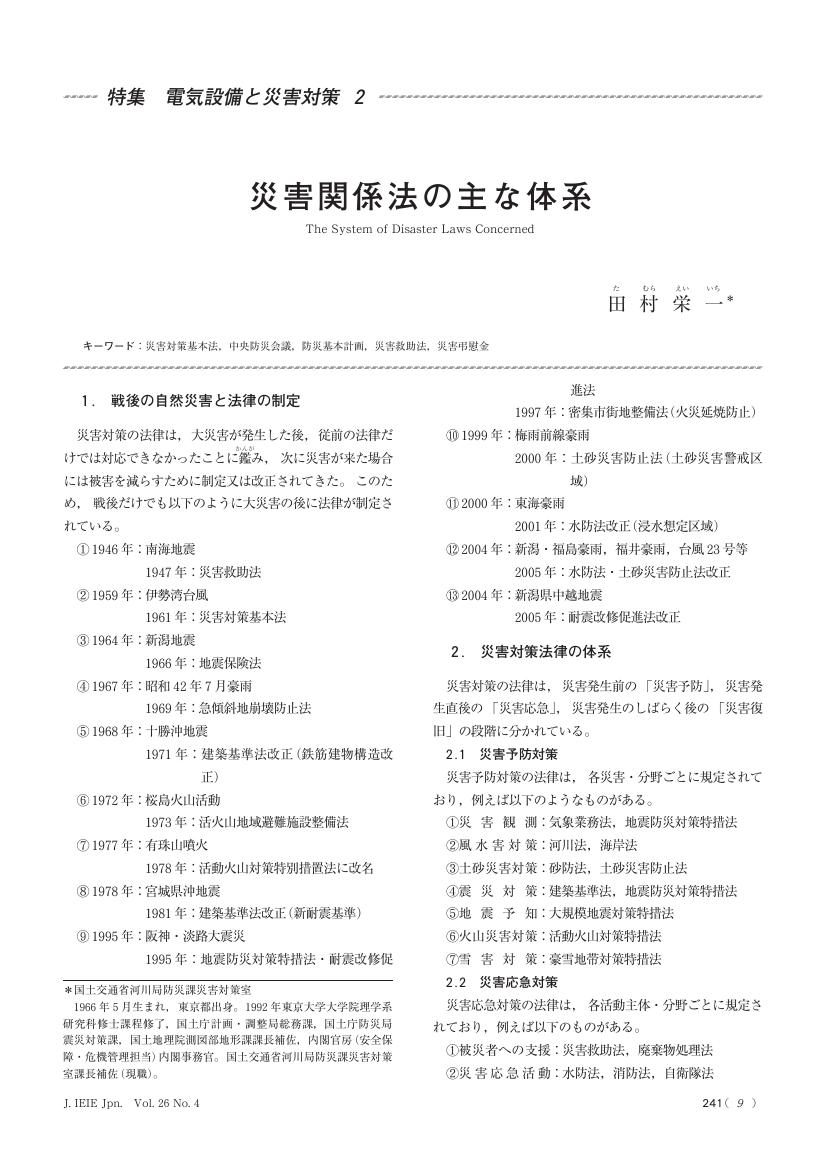1 0 0 0 OA 最近の災害対策について
- 著者
- 上総 周平
- 出版者
- 一般社団法人 電気設備学会
- 雑誌
- 電気設備学会誌 (ISSN:09100350)
- 巻号頁・発行日
- vol.26, no.4, pp.235-240, 2006-04-10 (Released:2015-06-12)
1 0 0 0 OA 災害関係法の主な体系
- 著者
- 田村 栄一
- 出版者
- 一般社団法人 電気設備学会
- 雑誌
- 電気設備学会誌 (ISSN:09100350)
- 巻号頁・発行日
- vol.26, no.4, pp.241-243, 2006-04-10 (Released:2015-06-12)
1 0 0 0 OA 建築物の耐震設計に関する最新の動向
- 著者
- 早野 裕次郎
- 出版者
- 一般社団法人 電気設備学会
- 雑誌
- 電気設備学会誌 (ISSN:09100350)
- 巻号頁・発行日
- vol.26, no.4, pp.244-247, 2006-04-10 (Released:2015-06-12)
1 0 0 0 OA 特集に当たって
- 著者
- 福嶋 宏一
- 出版者
- 一般社団法人 電気設備学会
- 雑誌
- 電気設備学会誌 (ISSN:09100350)
- 巻号頁・発行日
- vol.26, no.4, pp.234, 2006-04-10 (Released:2015-06-12)
1 0 0 0 OA 望診の客観化
- 著者
- 森 和 矢野 忠 芹沢 勝助
- 出版者
- The Japan Society for Oriental Medicine
- 雑誌
- 日本東洋醫學會誌 (ISSN:1884202X)
- 巻号頁・発行日
- vol.27, no.1, pp.125-138, 1976-08-30 (Released:2010-10-21)
- 参考文献数
- 31
1 0 0 0 OA 講演 和歌に依る法華経の解釈 ―慈円・尊円を中心に―
- 著者
- Robert Jean-Noël
- 出版者
- 国文学研究資料館
- 雑誌
- 国際日本文学研究集会会議録 = PROCEEDINGS OF INTERNATIONAL CONFERENCE ON JAPANESE LITERATURE (ISSN:03877280)
- 巻号頁・発行日
- no.26, pp.1-15, 2003-03-01
When it comes to the important question of religion and language in Buddhism, the importance of the Japanese language is wont to be underestimated. By comparison with medieval Chinese or Tibetan, Japanese obviously cannot boast of the same feats in translating the Buddhist Scriptures. Even in the case of Mongolian or Manchu, that former scholars tended to neglect, both these languages produced translations of the Buddhist Canon (albeit a partial one for the latter), which are to be taken, although they are secondary translations, as a landmark in the cultural history of East Asia.Japanese is prima facie different; there was no organized translations of the Canon in that language before modern times, and, in that respect, it would be closer to the situation of Siam or Cambodia. But there was indeed a field in which Japanese monk-scholars engaged in an enterprise that could be deemed akin to the achievements of their Tibetan counterparts, and that was the Japanese poetry (waka) on Buddhist themes, that I will here cover by the general term of “exegetical” poetry or shakkyou kaei.We may for our purpose propose here a broad division of those poems in two, namely those that make use of Chinese Buddhist vocabulary tel quel, and those that endeavor to rely exclusively on ‘pure’ Japanese poetical language.Taking the example of two corpuses of Buddhist waka poems on the theme of the Lotus Sutra by Jien and Sonen, I will consider three points:a) How the scholastic and religious vocabulary of Buddhism has been translated in original Japanese idioms.b) How the poetical expression of the Lotus tenets enhanced and developed the doctrinal interpretation.c) In what way this interpretation or exegesis fits into a precise pattern of religious practice. I hope, through these points, to make a step towards assessing this poetical genre as a full-fledged category of religious literature.
1 0 0 0 OA 鉄心斎文庫蔵「伊勢物語画帖」について
- 著者
- 土屋 貴裕
- 雑誌
- 美術研究 = The bijutsu kenkyu : the journal of art studies
- 巻号頁・発行日
- no.399, pp.1-36, 2010-01-07
The Tesshinsai Bunko Ise Monogatari Bunkakan in Odawara city, Kanagawa prefecture, is well known for its collections regarding The Tales of Ise. The single-volume The Tales of Ise Album (hereafter referred to as Tesshinsai version) is one of these works. It is thought that the paintings in the album were created by Tosa Mitsunobu and the text passages were brushed by Konoe Nobutada, as indicated by the inscription on the inside of the storage box lid. Not much attention has been accorded to the Tesshinsai version, and there have been no thorough studies of the work. This article is an introduction to the Tesshinsai version and presents observations that will hopefully advance an understanding of its position with the history of art. First, the article provides an overview of the work. It then goes on to evaluate the attributions to Tosa Mitsunobu and Konoe Nobutada. Similarities can be noted between the Tesshinsai version paintings and the group of works known to have been painted by Tosa Mitsunobu. However, there are also pages within the album that are extremely close to works by Tosa Mitsumochi, Mitsunobu's son, and the workshop of Mitsumochi, such as the Taimadera Engi Emaki and the Kuwanomidera Engi Emaki. Further, in terms of the text passages, the Tesshinsai version has gold and silver painted decoration rather than gold leaf decoration on its the text papers, and thus the paper used in the painting is thought to date from around the Momoyama period. The calligraphy appears to have characteristics typical of Konoe Nobutada, as found in works such as the Screens of Assorted Poems from the Tale of Genji in the Yômei Bunko collection. Thus the author concluded that it is highly likely that thecalligraphy is in fact that of Nobutada. Next, a comparison was made of scenes presented in various versions of The Tales of Ise paintings created up until the Momoyama period and the works in the Tesshinsai version, as a confirmation of their positioning within specific lineages of such works. As a result, the Tesshinsai version is seen to bear an extremely close relationship with the Chester Beatty Library version and the Suntory Museum of Art version. These two versions bear a close affiliation to the so-called Sagabon version that is considered to be the model for many Edo period examples. To be more specific, the Tesshinsai version appears to be the oldest copy version in this Sagabon lineage. This means that the Tesshinsai version must play a major role in future research on The Tales of Ise paintings. Given this chronology, the Tesshinsai version influenced many Tales of Ise paintings. Also, because it is considered that this work was painted by the Tosa Mitsumochi workshop, the Tesshinsai version stands as important material for the future study of the Tosa school. Finally, the Tesshinsai version was compared to the two Tales of Ise paintings created by Sumiyoshi Jokei, a painter who inherited and continued the Tosa school tradition. The comparison indicates that undoubtedly Jokei referred to the Tesshinsai version in the creation of his works. This connection also indicates the importance of the Tesshinsai version in the consideration of such issues as handing on models and copy works, and the development of Yamato-e iconography during the pre-modern period.
1 0 0 0 OA 池谷和信編:食の文明論――ホモ・サピエンス史から探る
- 著者
- 荒木 一視
- 出版者
- 公益社団法人 日本地理学会
- 雑誌
- 地理学評論 Series A (ISSN:18834388)
- 巻号頁・発行日
- vol.94, no.6, pp.468-469, 2021-11-01 (Released:2023-02-19)
- 参考文献数
- 1
- 著者
- 岡島 昭浩
- 出版者
- 日本語学会
- 雑誌
- 日本語の研究 (ISSN:13495119)
- 巻号頁・発行日
- vol.6, no.1, pp.53-47, 2010-01-01 (Released:2017-07-28)
1 0 0 0 OA 社会科における解釈型歴史学習の現代的意義
- 著者
- 土屋 武志
- 出版者
- 愛知教育大学
- 雑誌
- 愛知教育大学研究報告. 教育科学編 (ISSN:18845142)
- 巻号頁・発行日
- vol.61, pp.183-189, 2012-03-01
1 0 0 0 OA <研究ノート>南部氏側妾小考 : 重信の実母お松を事例に
- 著者
- 高橋 博
- 出版者
- 弘前大学國史研究会
- 雑誌
- 弘前大学國史研究 (ISSN:02874318)
- 巻号頁・発行日
- no.99, pp.36-42, 1995-10-30
1 0 0 0 OA 関節型ロボットアームの高速化のための運動制御 間欠運動の高速化に関する研究
- 著者
- 神谷 好承 岡部 佐規一 横山 恭男
- 出版者
- 公益社団法人 精密工学会
- 雑誌
- 精密機械 (ISSN:03743543)
- 巻号頁・発行日
- vol.47, no.6, pp.706-711, 1981-06-05 (Released:2009-06-30)
- 参考文献数
- 4
- 被引用文献数
- 1 1
This paper deals with the motion control of a manipulator or an industrial robot arm. Generally speaking, manipulators or industrial robot arms that are constructed by the open-loop articulated kinematic chains are non-linear dynamic systems and the motion equation is described by the coupling dynamic systems between the connecting chains. So it is not easy to control a manipulator or a robot arm for positioning to the desired place at high speed. In this study, for the high speed motion of a robot arm, we tried to adapt the minimum time control to the motion of robot arm that has two articulated kinematic chains, and found the optimal path to move the robot arm from the initial configulation to the final configulation. This optimal path is very similar to the figure of which we move our own arms. And we showed the way to solve the near-minimum-time control for the multi-input and non-linear dynamic system like a robot arm that is constructed by the open-loop articulated kinematic chains.
1 0 0 0 OA 包装材料の腐食作用に関する研究 (第3報)
- 著者
- 高橋 教司
- 出版者
- Japan Society of Corrosion Engineering
- 雑誌
- 防蝕技術 (ISSN:00109355)
- 巻号頁・発行日
- vol.10, no.9, pp.398-400, 1961-09-15 (Released:2009-11-25)
- 参考文献数
- 1
Kraft papers containing various amounts of Cl- and H+ were prepared in laboratry. A piece of the papers was put between two pieces of mild steel and the corrosive was tested under 40°C, 90% R. H. and room temperature. Corrosive action was evaluated by the measurement of rust degree of iron and steel specified by Japanese Industrial Specification.Results obtained were as follows:1) The allowable limit of Cl- is about 0.4mg per 1g of material and beyond the limit, a proportional relation between Cl- concentration and R was established, where R is rust degree of mild steel.2) The allowable limit of H+ concentration is approx. 6 in pH and in acid range, log R is proportional to pH value.
1 0 0 0 OA 住宅の防錆処理 自然環境と住居内環境について
- 著者
- 中野 宗太 多田 真作
- 出版者
- 一般社団法人 表面技術協会
- 雑誌
- 実務表面技術 (ISSN:03682358)
- 巻号頁・発行日
- vol.25, no.12, pp.579-585, 1978-12-01 (Released:2009-10-30)
- 参考文献数
- 12
1 0 0 0 OA 洗浄剤,スケール防止剤,冷却水防錆剤
- 著者
- 窪井 夏郎 室田 陽介 尾﨑 聡
- 出版者
- 公益社団法人 日本マリンエンジニアリング学会
- 雑誌
- マリンエンジニアリング (ISSN:13461427)
- 巻号頁・発行日
- vol.53, no.6, pp.769-776, 2018-11-01 (Released:2018-11-17)
1 0 0 0 OA 心理検査における回答の心理
- 著者
- 岩脇 三良
- 巻号頁・発行日
- no.23, 1971
- 著者
- 上野 博史
- 出版者
- 東京大学
- 雑誌
- 新学術領域研究(研究領域提案型)
- 巻号頁・発行日
- 2019-04-01
本研究では分子機械の改造・創成を実現する新規進化分子工学的スクリーニング技術の開発を行う。そのため1DNA隔離、タンパク質発現・精製、機能評価、DNA回収という進化分子工学的スクリーニングプロセスの全てをマイクロチャンバーデバイス内で実現する技術を開発する。これまでの研究から精製以外のプロセスのデバイス実装は完了している。そこで本研究では微小ドロップレット内でのタンパク質精製プロセスを組み込んだスクリーニング技術を確立する。さらに確立したスクリーニング技術を分子機械であるF1-ATPaseのスクリーニングへと拡張させ、分子機械の改造や新規機能の創成への適応を目指す。
- 著者
- 荒木 健哉
- 出版者
- 日本文化人類学会
- 雑誌
- 文化人類学 (ISSN:13490648)
- 巻号頁・発行日
- vol.83, no.1, pp.095-112, 2018 (Released:2019-02-24)
- 参考文献数
- 32
本稿はナイジェリアのラゴス州において、数字宝くじを購入する人々が宝くじの購入(消費)を余暇活動や娯楽ではなく、他の生計活動とは異なる独自の労働や仕事とみなす論理を、宝くじの当せん番号の予想をめぐる実践に着目して明らかにすることを目的とする。ギャンブルを対象とした人類学的研究では、不確実性の高い状況下において人々は生活のあらゆる側面を経済活動の領域に位置づけることが指摘されてきた。ナイジェリアにおいても宝くじを購入する人々は、生計多様化戦略の1つに宝くじの購入を位置づけている。しかし、その他の生計活動と宝くじでは、前者における不確実性が社会関係に起因しがちなのに対し、後者は最小限の人為性しか介入せず、ある種の公正さを伴う純粋なチャンスのゲームであることが異なっていた。他方で興味ぶかいことに、宝くじの購入者たちは、宝くじの幸運は受動的に降りかかってくるものではなく、一定の技術により主体的に獲得できるものだとみなしていた。本稿では、この予想をめぐる実践を検討し、彼らが予想の技術を何らかの認識論的な枠組みにおいて解釈せず、ただ<存在する>とみなすことを通じて希望を創造/贈与することを論じる。そこから宝くじの消費実践を生計実践=仕事に埋め込む論理を探る。
1 0 0 0 OA 蝦夷地と近世北奥羽 : 多様な交流と蝦夷地観
- 著者
- 長谷川 成一
- 出版者
- 北海道立文書館
- 雑誌
- 北海道立文書館研究紀要 (ISSN:09122575)
- 巻号頁・発行日
- no.17, pp.1-23, 2002-03-27








